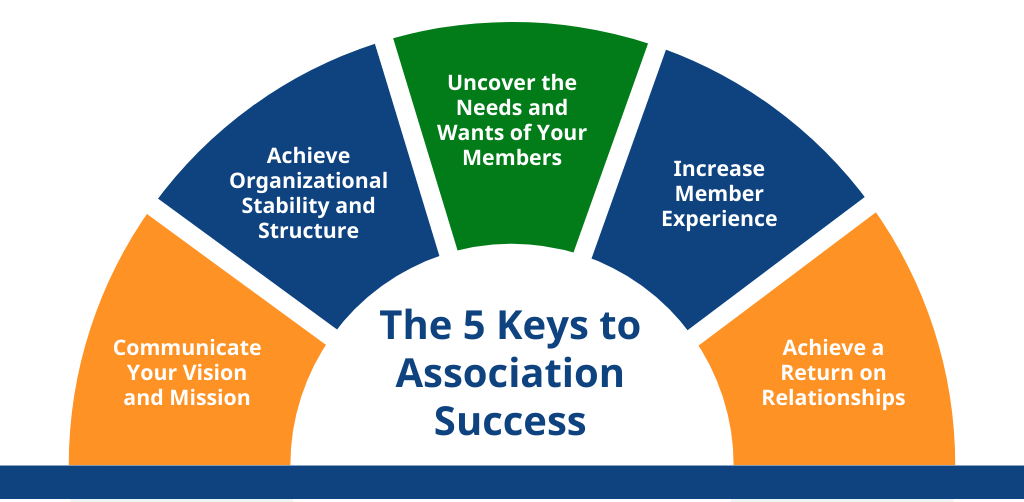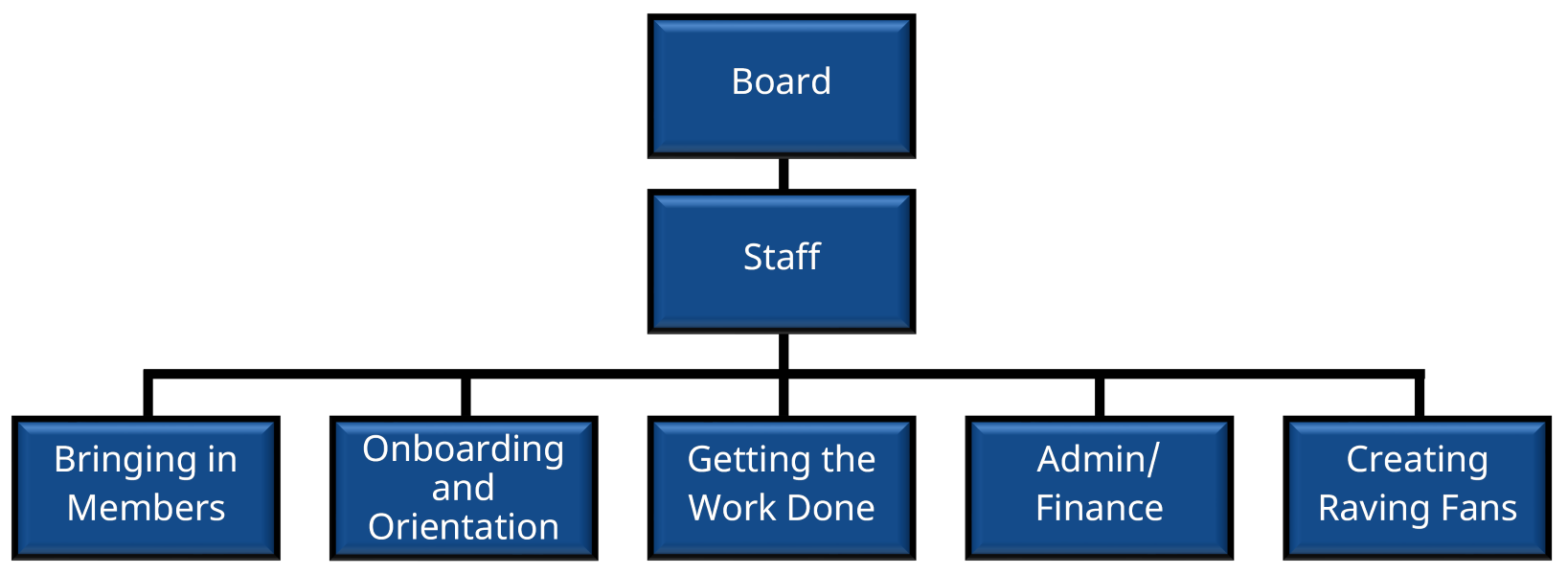When I ask an association board member, leader, staffer or committee head How is your association doing? I get a lot of different answers. Some answers are about membership: the number of new members, renewals, meeting attendees. Some answers focus on how much success the association is having building relationships with legislators and impacting regulations. Other answers emphasize culture, finances, events, continuing education, committees and affiliates. The answers are broad because the work of associations is broad. That’s exciting! Think about how much impact you can have! It can also be intimidating: Think about how much there is to juggle, wrangle, organize and administer—with mostly volunteers.
The good news is, you can get a handle on it—with the 5 Keys to Association Success.
Breaking Down the Work of an Association Into 5 Keys
How do you run a marathon? One step at a time. Almost anything big, complex and daunting can be broken down into smaller, less complex pieces. By breaking a big thing into components, we make it more manageable. More achievable. It’s easier to see the steps we need to take to make things happen.
In more than two decades working with associations at the local, regional and national level, I’ve found that the work of an association can be broken down into five components. I call them the 5 Keys to Association Success.

Let’s look at them one by one.
Key 1: Communicate Your Unique Value Proposition—Your Vision and Mission—to Your Members
People talk a lot about Unique Value Proposition (UVP) with regard to businesses. It’s the message a business uses to communicate its unique value and is essential to breaking through the noise of the competition and attracting best-fit clients. Having and using a UVP is just as important for your association. It enables you to share the importance of what you do and how others will benefit by being part of your organization.
Your UVP is comprised of the answers to three questions.
- Why do you do what you do? This is the purpose of your association: your vision and mission. It’s why your association exists and what you want to accomplish. For NAHB, that purpose is: “The National Association of Home Builders of the United States strives to protect the American Dream of housing opportunities for all, while working to achieve professional success for its members who build communities, create jobs and strengthen our economy.”
- Who do you serve? This is your target market, the specific audience who most benefits from joining and engaging with your association. For the South Carolina Aggregates Association (SCAA), those members are stone, sand and gravel producers, as well as the equipment manufacturers and service providers who support them.
- What makes you different? There are a lot of associations out there. You might be tempted to think that you have the membership market cornered if you are, for instance, the only widget industryrelated association in your area. The reality is that your potential members also have the option of joining a chamber of commerce, an association focused on networking or even a social or civic organization. If you want them to spend their time—and their dues—on your association, you need to be able to communicate what’s in it for them. More about that below.

It's such an important word: communicate. You might have an incredible mission, with a niche audience hungry for the amazing benefits that only you can provide, but if you don’t get the word out, you might as well not exist.
So first, you have to communicate your Unique Value Proposition to potential members—and to your current members, for that matter. Reminding them why they joined and what they’re getting from it is the most effective way of getting that renewal every year. We could also call Key 1 Getting Fannies in the Seats.
It’s the first step to attracting the members and partners you need so that your association can grow and make an impact in your industry.
Key 2: Achieve Organizational Stability and Structure
This Key is about the foundation of your organization: how healthy it is and how well it works. If you don’t have a healthy, well-run association, you won’t be able to get off the dime to fulfilling on the promise of your UVP.
A quick note here: You might ask why this isn’t Key 1, if it’s so foundational. The answer is that this Key is about setting your association up to succeed, and you can’t set it up to succeed until you truly understand what you’re trying to succeed at. Whether you’re running a business or an association, everything revolves around vision and mission. That has to come first.
So, how do you set your association up to succeed?
First, make sure your association can run effectively and efficiently. All of the tasks your association does can be categorized into another set of five: the 5 Functions of Associations. When you organize the work of your association around these functions, things run smoothly because there are clearly delineated tasks and lines of responsibility. Board members, staff and volunteers love this because it makes it easy to sign up for a manageable, understandable task or set of tasks—and that keeps everyone from being overwhelmed and getting burned out, which is a perennial problem for associations.

Second, know your numbers. Just like in a business, your association should be setting annual goals related to membership numbers and revenue targets, and working to achieve those. If you don’t have a system in place to do that, please
Once you’ve set your annual goals, you want to keep an eye on how you’re doing against them. Some helpful numbers that I find that boards don’t always track—and that surprise them when they do—are:
- Membership versus non-membership dues. The proportion of membership dues to nonmembership dues (sponsorships, grants, etc.) will vary for every association; for some it will be 50-50, others 40-60. Consult with your national organization to determine what a healthy mix is for you.
- Sponsorship revenue. This is a more important component of revenue than organizations realize. It is a robust source of revenue and also helps build relationships in the community.
- Number of members attending meetings and events. This is a great way of measuring members’ excitement. Members who don’t regularly attend are less likely to volunteer and less likely to renew.
- Cash reserves. Emergencies happen; it’s important to have cash on hand to handle them.
Key 3: Uncover the Needs and Wants of Your Members
Members are the lifeblood of an association. Their dues enable your association to meet its revenue goals; the power of their presence gives your association clout in your industry; they’re the volunteers who serve on committees, organize events, greet newcomers to meetings and make things happen.
The associations that thrive are the associations that truly understand their members and dedicate themselves to providing the kind of value that motivates members to get involved and to renew, year after year. To do that, you have to know what your members need—and what they want—from your association.

The most effective way I’ve found of doing that is asking them. The best tool for that is a strategic survey. You can learn more about strategic surveys and why members do and don’t show up to events in my blog and podcast How to Boost Your Association’s Member Engagement.
It’s not enough, of course, to understand what your members need and want. You need to deliver—and let them know you’re delivering. Communicating your offerings and helping your members understand the value of those offerings to them are vital to increasing member experience, which is Key 4.
Key 4: Increase Member Experience
I always tell businesses that creating raving fans who refer isn’t about providing exceptional customer service; exceptional customer service is the baseline. To stand out from the competition, businesses have to deliver an experience that surprises and wows. Associations are no different.
I cover member experience in-depth in my blog Leveling Up Your Member Engagement, but here's the short and sweet version: Member experience is all about culture. It’s about drawing your members into the family of your association and helping them feel a part of your community.
How do you know if you have a great culture? Ask yourself: If I had to walk into one of our meetings or events without knowing anyone at all, how would I feel? Would attendees greet you warmly and introduce you around? Would someone reach out to you afterward to invite you to the next event? Would you pretty quickly understand how to get involved and feel like your involvement was welcome and important?
If your answer isn’t YES! to all of those questions, it’s time to do some deep thinking about how you can enrich the culture and experience of your association.
Key 5: Achieve a Return on Relationships
Member experience is culture-focused and more about the personal experience members have when engaging with your association. Key 5 is about the bottom line: How membership in your association helps your members succeed in their business.
One part of this is return on investment. That’s about money: Your association’s membership should pay for itself in three to six months, in value brought to your member and their business. Members can get that by getting referrals that result in closed business, education that makes them better at performing their job or regulations and laws that make it easier for them to do business.
The other part is return on relationships. That’s about making deep, meaningful connections with people who make a difference for your members. Those connections can be business-related, but they can also be personal. One of my most popular talks, How to Take the WORK Out of Networking®, teaches members how to build those priceless relationships. If you’d like to bring this talk to your members, please
*BONUS Key* Get an Assistant

The 5 Keys can be a game-changer for your association—if you actually implement them. You don’t have to do that all by yourself, and you shouldn’t. This is an exciting endeavor for your entire board, your staff and your members to get involved in. I’m here to help, too.
Also, get an assistant. Whether full- or part-time, in person or virtual, a good assistant is a lifesaver. Learn why having an assistant is so important and how you can afford one in my podcast Getting Assistance for Your Association.
Use the 5 Keys to Drive Association Success
When you put the 5 Keys to work for your association, you will be amazed at how easy it can all feel: easy to attract and engage the kinds of members who are excited about your mission; easy to meet your financial goals; easy to fill your committees and run events that make a difference for your members and your industry; easy to avoid burnout. All with just 5 Keys:
- 1. Communicate your Unique Value Proposition—your vision and mission—to your members.
- 2. Achieve organizational stability and structure by using the 5 Functions to enable your association to run effectively and efficiently, by understanding your financial goals and by knowing your numbers.
- 3. Uncover the needs and wants of your members by sending out a strategic survey and acting on what you learn from it.
- 4. Increase member experience by building a warm, welcoming culture that inspires members to get involved and makes it easy for them to do so.
- 5. Achieve a return on relationships by helping your members succeed in their business and making connections with people who make a difference for them.
I’ve covered a lot here, and there’s some work to be done before things start to feel easy. If you want to dig deeper into any of these 5 Keys, please




































































